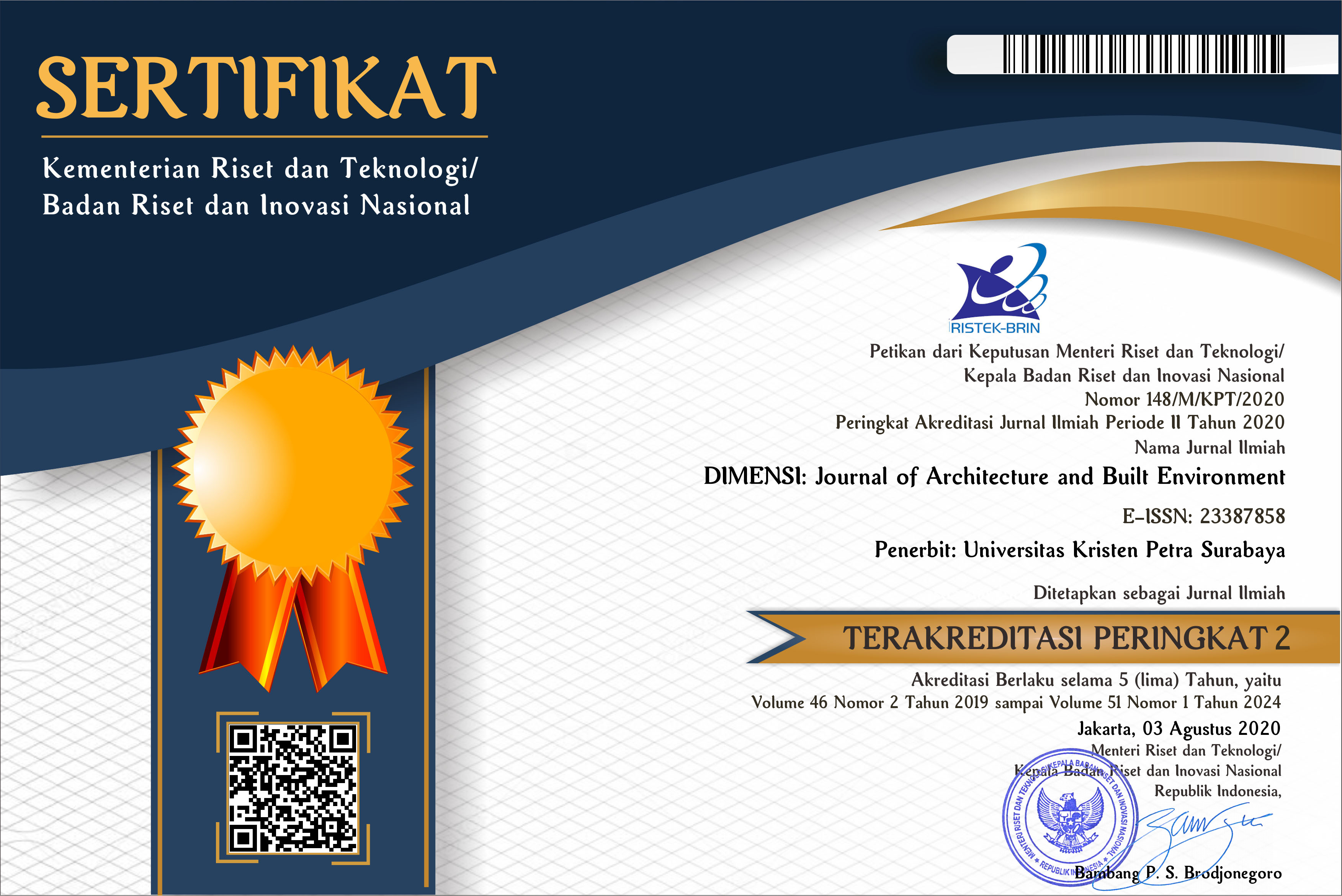BUILT ENVIRONMENT IMPACT TO MICROCLIMATE (AIR TEMPERATURE)
 :
:
https://doi.org/10.9744/dimensi.46.1.23-34
Keywords:
Microclimate, Temperature, Trade area, Impact, PontianakAbstract
In step with economic growth, Pontianak City continues developing its physical development. From an environmental perspective, physical development that does not pay attention to the environment may make air temperature rise and create inconvenience to human. The purpose of this study is to evaluate the tendency in the built/physical environmental aspects that have the possibility of influencing the microclimate in the urban center, regarding the trade area in Pontianak City. Built environmental aspects such as building density, building height, materials, etc. are described and then simulated towards the existing climate elements such as temperature, humidity, solar radiation, cloud cover, and others. The simulations used three-dimensional software ENVI_MET version 4. From findings, it can be seen that the built environment characteristics can affect the microclimate condition. From the simulations, the dominant temperature differences may occur in such built environment conditions such as density, dimensions, location, material, and vegetation closure.
Downloads
References
Alwetaishi, M., A Balabel. (2016). Effect of Microclimates Conditions on Architectural Design of Residential Buildings in Saudi Arabia. European Journal of Advances in Engineering and Technology, 3(8): 29-32
Antara News – Economic development in Pontianak, https://kalbar.antaranews.com/berita/360326/pertumbuhan-ekonomi-pontianak-ditargetkan-610-persen, accessed 2018
Chokhachian, Ata. (2017). How Material Performance of Building Façade Affect Urban Microclimate. Accessed from https://www.researchgate.net/publication/312612614, 2018
Deng, Ji-Yu. (2016). The Study of the Effects of Building Arrangement on Microclimate and Energy Demand of CBD in Nanjing, China. 4th International Conference on Countermeasures to Urban Heat Island (UHI), Procedia Engineering 169 ( 2016 ) 44 – 54
Duarte, Denise H.S. (2015). The impact of vegetation on urban microclimate to counterbalance built density in subtropical changing climate. Urban Climate 14 : 224–239
Elnabawi, Mohamed H., dkk. (2013). Use And Evaluation Of The Envi-Met Model For Two Different Urban Forms In Cairo, Egypt: Measurements And Model Simulations. 13th Conference of International Building Performance Simulation Association, Chambéry, France
ENVI_MET – ENVI_MET Software, http://www.envi-met.com/buildings-and-climate/, accessed 2018
Kakon, Anisha Noori ., Nobuo, Mishima. (2009). The Sky View Factor Effect On The Microclimate Of A City Environment: A Case Study Of Dhaka City. The seventh International Conference on Urban Climate,Yokohama, Japan
Klein, Ján., Zdenka Rózová. (2014). Impact of Vegetation on Microclimate in Different Layouts of Built- Up Areas in Urbanised Environment of Nitra Municipality in Spring Period. Rožnovský, J., Litschmann, T., (eds): Mendel a bioklimatologie. Brno, 3. – 5. 9.
Kushol, Syed Abu Sufian, dkk. (2013). Effect of Street Morphology on Microclimate in Residential Areas Following FAR Rule in Dhaka City. PLEA2013 - 29th Conference, Sustainable Architecture for a Renewable Future, Munich, Germany
Langer, Ines. (2012). Using the ENVI-MET program to simulate the micro climate in new Town HASHTGERD. The international conference on Computing, Networking and Digital Technologies, (SDIWC 2012), S. 61–64.
Lee, Gunwon., Yunnam Jeong. (2017). Impact of Urban and Building Form and Microclimate on the Energy Consumption of Buildings - Based on Statistical Analysis-. Journal of Asian Architecture and Building Engineering, Vol.16, No.3 : 565- 572
Nasira, Diana SNM., et. al. (2016). Effect Of Urban Street Canyon Aspect Ratio On Thermal Performance Of Road Pavement Solar Collectors (RPSC). The 8th International Conference on Applied Energy.
Ok, Vildan., et. al. (2014). Effects Of Urban Structure To Microclimatic Conditions In Hotdry Climatic Zone; A Case Study in MARDİN Enes Yasa. Accessed from https://www.researchgate.net/publication/320002903, 2018
Pandya, Sujal V., Luisa Brotas. (2014). Tall Buildings and the Urban Microclimate in the City of London. 30th International Plea Conference, CEPT University, Ahmedabad
Pisello, Anna Laura. (2015). The Impact of Local Microclimate Boundary Conditions on Building Energy Performance. Sustainability, 7, 9207-9230; doi:10.3390/su7079207
Pontianak City Statistical Agency – Statistical Data, https://pontianakkota.bps.go.id/, accessed 2018
Santamouris, M., et. al. (2012). Using Cool Paving Materials To Improve Microclimate Of Urban Areas – Design Realisation And Results Of The Flisvos Project. Building and Environment, Vol. 53, Pages 128-136
Sanusi, Ruzana., et. al. (2015). Street Orientation and Side of the Street Greatly Influence the Microclimatic Benefits Street Trees Can Provide in Summer. Journal of Environmental Quality.
Shafaghat, Arezou., et. al. (2016). Street Geometry Factors Influence Urban Microclimate In Tropical Coastal Cities: A Review. Environmental and Climate Technologies.
Shashua-bar, limor.,yigal tzamir and milo e. Hoffman. (2004). Thermal Effects Of Building Geometry And Spacing On The Urban Canopy Layer Microclimate In A Hot-Humid Climate In Summer. International journal of climatology. 24: 1729–1742
Shishegar, Nastaran. (2013). Street Design and Urban Microclimate: Analyzing the Effects of Street Geometry and Orientation on Airflow and Solar Access in Urban Canyons. Journal of Clean Energy Technologies, Vol. 1, No. 1.
Strelková, Monika. (2013). Influence Of Vegetation On Microclimate In The Urban Environment. Folia Oecologica, Vol. 40, No. 2.
Suara Pemred Kalbar – The development of Hotel in Pontianak, http://www.suarapemredkalbar.com/berita/ponticity/2018/01/22/pertumbuhan-hotel-stagnan-pontianak-miliki-4160-kamar, accessed 2018
Thetanjungpuratimes – Traditional Markets are getting Stuck, http://thetanjungpuratimes.com/2016/02/22/pasar-tradisional-makin-terjepit/, accessed 2018
Downloads
Published
How to Cite
Issue
Section
License
Authors who publish with this journal agree to the following terms:
- Authors retain copyright and grant the journal right of first publication with the work simultaneously licensed under a Creative Commons Attribution License that allows others to share the work with an acknowledgement of the work's authorship and initial publication in this journal.
- Authors are able to enter into separate, additional contractual arrangements for the non-exclusive distribution of the journal's published version of the work (e.g., post it to an institutional repository or publish it in a book), with an acknowledgement of its initial publication in this journal.
- Authors are permitted and encouraged to post their work online (e.g., in institutional repositories or on their website) prior to and during the submission process, as it can lead to productive exchanges, as well as earlier and greater citation of published work (See The Effect of Open Access).


















